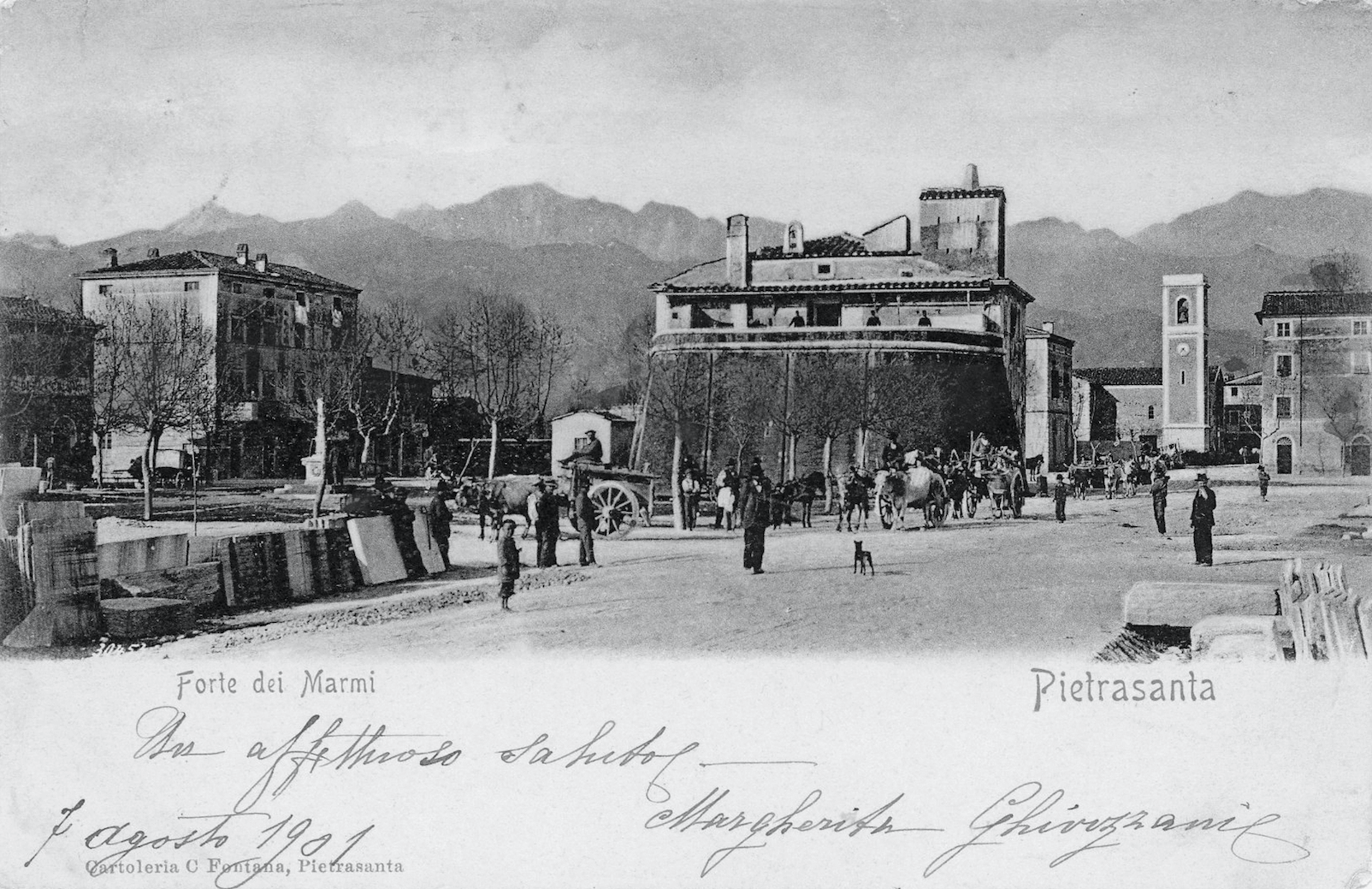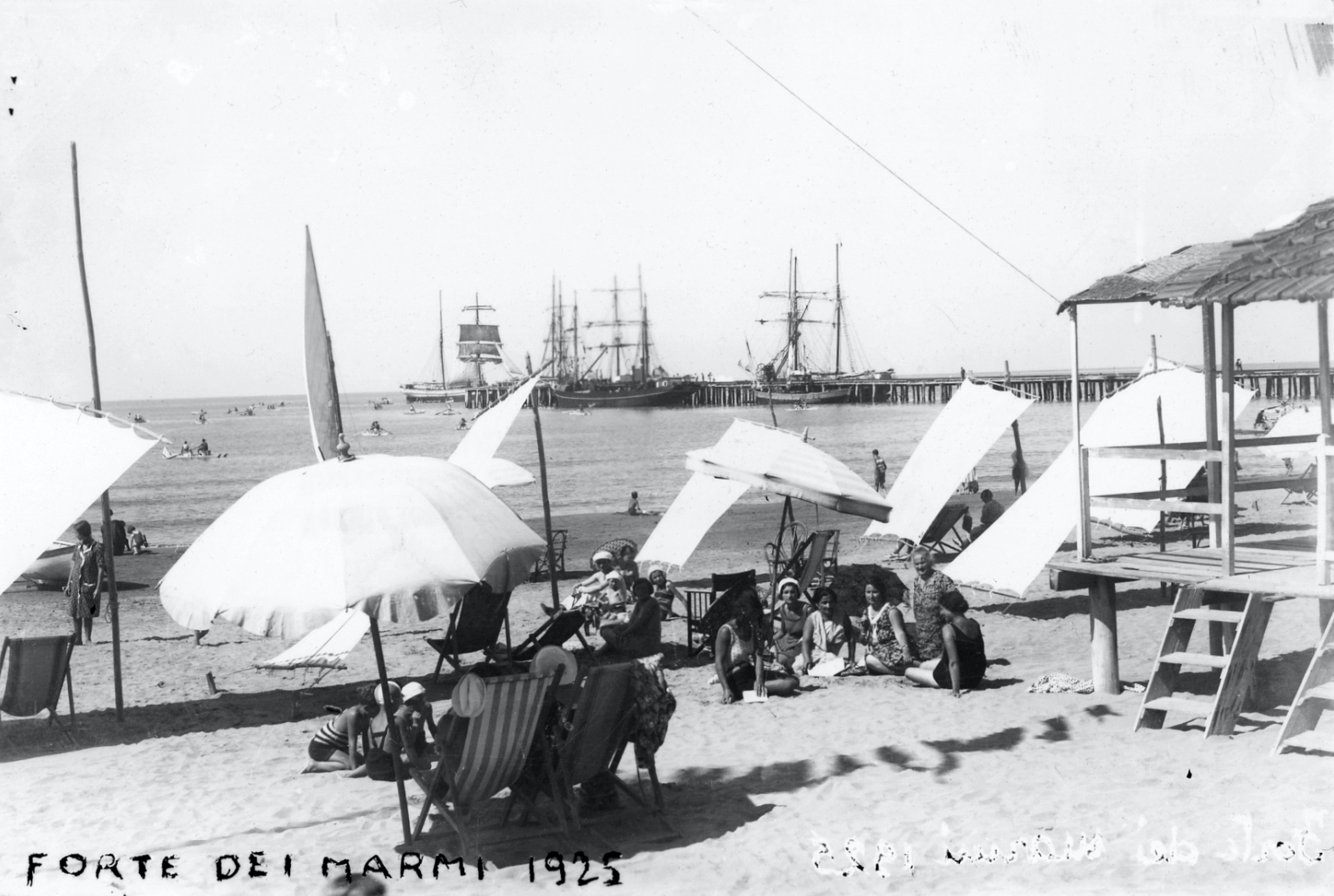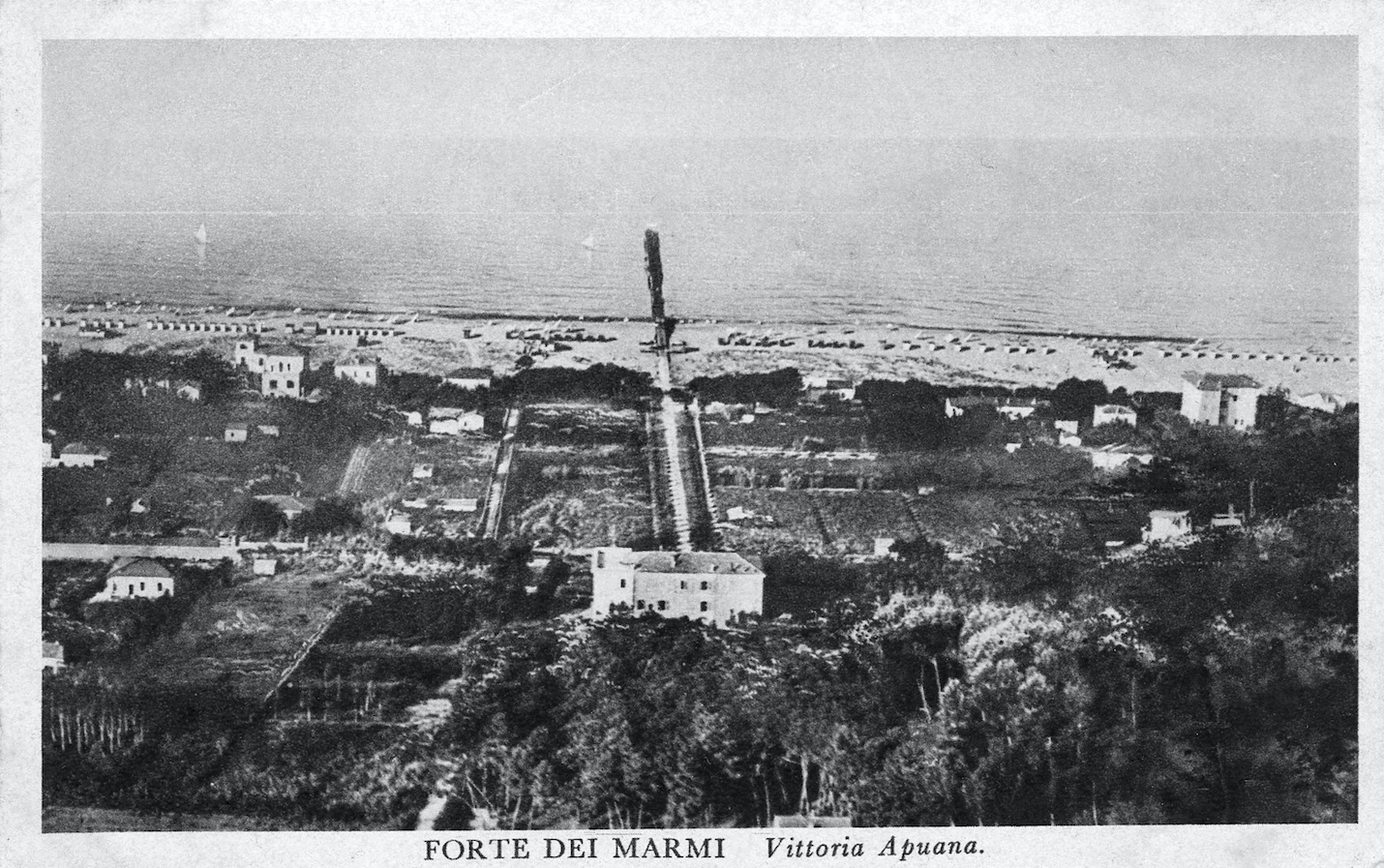Itineraries in Forte
Itineraries in Forte
FORTE CENTER, ARTS AND BOUTIQUES

Pontile – Center – Capannina
1 – 2 km
This short route through the center of Forte dei Marmi is ideal for an outing on foot, although you may want to go by bike if you intend to continue farther afield. The panorama from the Pontile, Forte’s strictly pedestrian pier (not even bikes are allowed!), takes in the sea, the coast from the islands off La Spezia all the way to Viareggio and, behind you, the Apuan Alps. Every year, the pier is the stage for a grandiose fireworks display as part of the celebrations for Forte’s patron Sant’Ermete on 28 August.
Dominating the circular plaza giving access to the Pontile is the bronze sculpture Controvento, by Anna Chromy, representing a helmsman navigating toward the unknown. Across Viale Italico, at the corner of Via Spinetti, are the remains of the crane – nicknamed “La Mancina” because it rotated only to the left – that once loaded marble blocks onto merchant ships from the old wooden pier. Destroyed during World War II, the crane was recovered from the sea bottom, in pieces, and is now a monument to the workers of the sea installed in the pinewood dedicated to Giovanni Falcone and Paolo Borsellino.
Another monument in the same pinewood is a pattino, a typical Versilian lifeguard boat, a hymn to the expertise of the local maestri d’ascia boatbuilders.
Continue past this pinewood park along Via Spinetti, the palm-shaded main street leading to the shops and boutiques of the city center. A few more meters and you’re in Piazza Garibaldi, in the very center of historic Forte, where you’ll find the Fortino and the Pozzo (water-well). Against the front wall of the Fortino, the basin that was once a watering trough for the beasts of burden that transported the marble from the mountains to the sea is now surmounted by Arturo Dazzi’s statue Vittoria. Also on the square is a beautiful fountain erected in 1900 by the municipality of Pietrasanta (in what was then still a locality of this Comune) to provide drinking water, and the sculpture by Gio Pomodoro entitled La Figlia del Sole. The square is a prestigious venue for musical events and spectacles, including the Focata bonfire set ablaze during the late-August celebrations for Forte’s patron Sant’Ermete. The benches on the square are perfect for a short pause in your wanderings – or you might prefer a snack or an aperitif at the Caffè Roma, near what was, in the early years of the last century, a habitual meeting-place for such intellectuals, artists, and writers as Carlo Carrà, Arturo Dazzi, and Enrico Pea.
Continuing north from Piazza Garibaldi, you’ll soon come to the lovely gardens in Piazza Dante and the building, raised in 1922, that is now the Forte dei Marmi City Hall. A travertine marble monument to the fallen of all wars stands in the center of the square.
If you turn south from Piazza Garibadi, instead, your path will lead past the Caffè Principe and then to Palazzo Quartieri, home to two very important municipal resources: the tourist information office and the library. The recently-restructured library now offers avant-garde multimedia services and serves as a venue for cultural events; its collection includes extensive topical reading material and many in-depth studies of local history. Palazzo Quartieri looks out on Piazza Marconi, with its paved ring enclosing a shady pinewood with rides (carousels and more), go-karts, and pony carts. Every Wednesday throughout the year (and Sundays in the summer), the square is the venue for Forte’s renowned street market.
Continuing in the same direction, you will come to a charming small square with a marble sculpture-bench Rosalba Gilardi, both titled to poet and writer Eugenio Montale. Now, if you head toward the sea, you’ll come to the historic La Capannina di Franceschi, a famous nightspot popular since the 1930s.
Return to the Pontile along the seafront boulevard titled to the Capannina’s first owner, Achille Franceschi, who besides founding the nightspot, after the war imparted a notable impetus to tourism in Forte. Along the boulevard, note the bust of local actor Renato Salvatori, who reaped considerable success in the cinema of that same postwar period.
THE VILLAS OF ROMA IMPERIALE

2 km
Jump on your bike on a lazy summer day and enjoy a short ride to discover the beautiful villas of Roma Imperiale.
From the Pontile, take the bike lane along the seaside boulevard as far as Via XX Settembre and then turn into the Roma Imperiale garden district. The neighborhood takes its name from the Società Cooperativa Anonima Roma Imperiale, which in the early years of the century purchased the land and sold off the lots to wealthy vacationers. The unparalleled green setting, a step from the sea, abounds in beautiful homes, for many of which the architects of the era made use of precious local materials. The first cluster of villas was built for the “colony” of Germans, artists and others, attracted by Dr. Carlo Vanzetti’s pioneering research in heliotherapy treatments, who came to Forte dei Marmi to benefit from the health benefits of the sea and the sun.
From Via XX Settembre, near the Necchi-Balloni municipal stadium, turn into Via Corsica to admire the Mediterranean Rationalist architecture of Villa Antonietta with its wraparound glass, a perfect solution for a seaside villa. Continue into Via Raffaelli to Casa Mann Borgese, built in 1957 by Leonardo Ricci, Giovanni Michelucci’s student and assistant, for the daughter of German writer Thomas Mann. The building patently recalls the outline of an ocean liner, ready – as its owner remarked – “to sail toward the mountains.” From Via Raffaelli, any turn you take into silent and shady surrounding streets will leave you entranced by the beauty of the architectural styles, the luxuriance of the gardens, the simple tranquility you’ll find there.
Via Leonardo da Vinci is the site of the majestic Villa Apuana, of Tuscan Renaissance inspiration, built by architect Carl Sattler for the Siemens family of German industrial magnates. The parallel Via Nizza takes you to Villa Costanza, raised for Admiral Enrico Morin in 1899 and sold to the Agnelli family in the 1920s. Attentive philological restoration transformed it into the well-known Hotel Augustus, which combines top-flight services with a very special style imbued with a palpable aura of times past.
Roma Imperiale is also the setting for an art-and-landscape itinerary that winds through the district, touching the sites where painter Carlo Carrà stood to paint along the Fosso Fiumetto; each “lookout” is marked by one or more reproductions of the landscapes he painted.
THE SEA AND THE MOUNTAINS

Pontile – Vittoria Apuana – Lago di Porta – Villa Bertelli
2.5 km
By bike or by car, this is a perfect excursion for enjoying the uncontaminated nature that surrounds Forte dei Marmi.
Start at the Pontile, in front of the historic Compagnia della Vela. If you’re biking, ride up the bike lane alongside the seaside boulevard; you’ll arrive in the Vittoria Apuana locality and then at the point where Forte dei Marmi becomes Cinquale (in the Comune di Montignoso in the Province of Massa Carrara), at the mouth of the Versilia River.
Since 2008, this last stretch is part of the Dune di Forte dei Marmi Protected Natural Area, managed by WWF Alta Toscana to preserve what remains of Versilia’s ancient coastal landscape along the only stretch of the entire Tuscan coast to unite natural dunes and the “original” backdune woodland vegetation. The oasis abounds in plants rarely found in Italian coastal habitats, such as Solidago litoralis Savi, Centaurea aplolepa subsp. subciliata DC., and the marvelous Anthemis maritima L.
Info and bookings for guided tours:
Viale Italico · Località Vittoria Apuana
mobile: +39 360 234789
https://www.wwf.it/oasi/toscana/dune_di_forte_dei_marmi
Safeguarding the environment is a top priority for the Comune di Forte dei Marmi. The many green areas in the Vittoria Apuana territory, as throughout Forte, testify to this commitment: in this locality, of particular note are the area behind the seaside boulevard and another in Via Carena, which lies beyond the vast grassy area reached by taking Via Giulio Cesare.
From this quiet inland district of the locality, with its villas and gardens, take Via Canova and Via Civitali to the Palazzetto dello Sport, Forte’s venue for rink hockey, a sport in which the Forte dei Marmi team has been Italian and European champion. Along Via Civitali, you’ll find the home of Ugo Guidi (1912-1977), now a house-museum, filled with sculptures and other works by the master (and long-time professor at the Accademia di Belle Arti of Carrara). His works can be found even at the Hermitage Museum of Saint Petersburg; pride of place at the Italian Football Federation’s Centro Tecnico Federale di Coverciano (Florence) is given to his 1974 travertine sculpture Calciatori (Footballers). Follow Via Gramsci to Piazza Donatori del Sangue, the site of Forte’s primary and secondary schools.
Now, if you continue on a mountain heading (along Via della Sipe), stop on the Genova-Livorno highway overpass to admire a fine panorama of the mountains and the sea. Below, you will note the ruins of the industrial buildings owned by SIPE, the Società Italiana Prodotti Esplodenti, which in the early 1900s manufactured and exported explosives and ammunition. Nearby, in stark contrast, the manicured expanses of the famous Versilia Golf Resort.
And abutting the golf course, the Lago di Porta Protected Natural Area, open to the public year-round, is the last relict of the wetlands that covered an extensive area inland of the Versilia shore until about 1500. A ring trail, for the most part running along the embankment that surrounds the area and along the Versilia river, lets you visit this unique wetland ecosystem on your own or with a guide; the trail can be completed in less than an hour on foot, by mountain bike, or on horseback.
Head back toward the sea along Via Padre Ignazio da Carrara – the main street of the Vittoria Apuana locality – to the central church of San Francesco and to view Arturo Dazzi’s monument to the saint. The small center of the locality – the name “Vittoria Apuana” was suggested by Florentine architect Adolfo Coppedè – is home to a great number of meeting and eating places. A few meters down Via Mazzini take you to the beautiful Villa Bertelli. The building once housed the offices of SIPE; after SIPE closed, it was sold to Ilio Bertelli and transformed into a pensione; today, it is owned by the Comune di Forte dei Marmi and is a prestigious venue for exhibitions and cultural events. Continue down Via Mazzini to return to the center of Forte dei Marmi.









